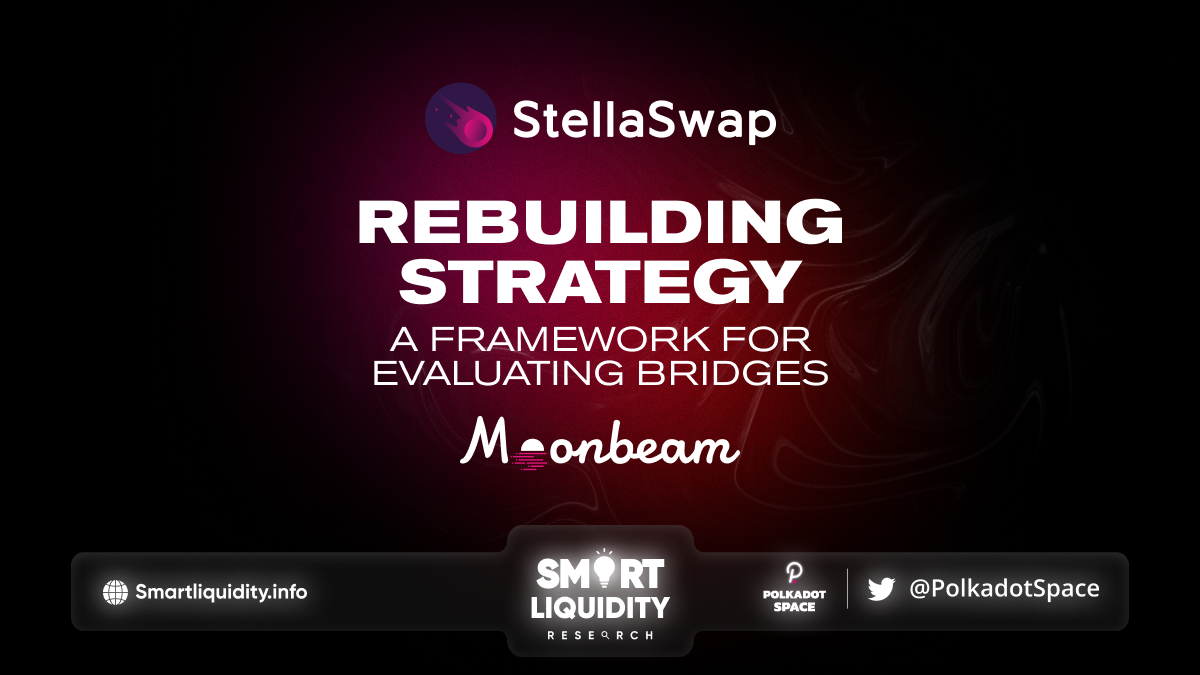StellaSwap Rebuilding Strategy


StellaSwap Rebuilding Strategy: A Framework for Evaluating Bridges on Moonbeam
The StellaSwap Rebuilding Strategy. It has been a tough journey for StellaSwap and the overall ecosystem in navigating across the black hole emanating from Nomad’s bridge exploit. Looking ahead entails ensuring that we plan for the infrastructure towards rebuilding, as well as enabling recourse for Nomad assets for when it is finalized.
It is therefore vital to ensure that there is a robust and rigorous process of analysis for key design decisions affecting the community. Given the move towards governance from both Moonbeam and Moonwell, it is all the more important for design decisions to be scrutinized and discussed so that the final decision takes into consideration all parties within the burgeoning Moonbeam ecosystem.
Introduction to Potential Bridges on Moonbeam
StellaSwap is proud to have worked with various bridge providers since the inception. They have maintained great relationships with Multichain and Axelar, two leading bridges that needs no introduction. More recently, we have had conversations with Wormhole, one of the biggest bridges in the space.
It takes no guessing to figure out that either of these bridges will become StellaSwap’s strategic bridge, in replacement of Nomad. Here is a high-level overview of each bridge;
- MultiChain: Multichain is a cross-chain router protocol that is currently one of the most popular bridges in DeFi. With a total TVL exceeding $2.5 billion across 62 different blockchain networks, Multichain has possibly the largest market share in the space.
- Axelar: Axelar is a permissionless overlay network that has been at the forefront of pioneering work on cross-chain communication with its general message passing (GMP). Axelar was recently chosen as the official cross chain service provider for Osmosis, the largest DEX on Cosmos.
- Wormhole: Wormhole is a generalized cross-chain messaging platform connecting high-value blockchains together, with applications leveraging the messaging layer to facilitate interoperability between ecosystems. Wormhole backed by Jump, a behemoth with tentacles across market-making, a venture capital arm and, increasingly, a team of in-house developers who contribute to projects on several major blockchains.
Bridge Evaluation Parameters
This section discusses several parameters to evaluate a bridge.
- Security: The most vital factor for evaluation, covering trust mechanism and security assurances. The former covers the spectrum of trust assumptions embedded within their logic and (operational) verifiers instituted in the system, while the latter covers the depth of audits, code deployment process and external bounties.
- Financial Coverage: The degree of financial backing, whether internally embedded within the protocol’s model (i.e. reserve fund) or externally via a network of backers, in the adverse event of any exploit.
- User Experience: The overall experience when using a bridge including usability, intuitiveness, speed and slippage, amongst other things.
They shall explore each parameter for each of the aforementioned protocols together with the context of the general Moonbeam ecosystem.
Evaluation Parameter #1: Security
It is no surprise that the biggest hacks recorded in DeFi are bridge exploits, as the cumulative amount of funds locked in bridges make them a primary target for attackers. The Nomad exploit underlined the need for a comprehensive and fully robust security framework; it is simply not enough to have a secure architectural logic without a corresponding emphasis on secure operational measures. In fact, 3 out of 4 of the biggest bridge hacks — Ronin, Womhole and most recently Nomad — was due to operational failures.
It is therefore vital to analyze the full-suite of security elements that not only include the architectural logic, but also — with equal emphasis — the respective operational security measures and safety measures determining the protocol’s code quality.
Evaluation Parameter #2: Financial Coverage
Close to $2 billion has been compromise in cross-chain exploits so far in 2022. This is expect to be a recurring theme in DeFi, given the infancy of the technology. Cross-chain bridges are especially vulnerable, given the sheer amount of funds locked in their respective smart contracts. As robust and comprehensive the security of a protocol is, there is no guarantee that it can protect itself from any and every threat.
Therefore, it is vital to assess a bridge’s ability from a financial coverage point-of-view. Generally, a bridge that possess the financial capacity to backstop losses due to an exploit would exhibit greater levels of confidence. Let’s take a look at two opposite examples of bridges with financial coverage;
- Nomad Bridge Exploit: Nomad bridge was exploited on the 1st of August this year, resulting in a loss of more than $186 million. As the defacto bridge of Moonbeam, many affected users saw their funds diminish in value and thee overall ecosystem TVL plummeted from $187 million to sub-$60 million. Users and affected protocols, like StellaSwap, is still awaiting for the resolution plan from Nomad
- Wormhole Bridge Hack: On Feb 2 this year, Wormhole’s bridge was exploited for $320 million (120k ETH). Within 24 hours, the vulnerability was fix and the bridge resume operations after Jump Crypto, the backers of Wormhole, backstop the bridge. As users were whole, confidence was restore and ecosystem TVL recovered within days.
Evaluation Parameter #3: User Experience
In the long-run, the popularity of any bridge will depend on its usability and overall user experience. Users must generally be happy with the bridging experience for a bridge to be successful. StellaSwap has worked with Multichain, Axelar, Nomad and Celer, allowing us to fully understand the variables that goes into analyzing an optimized user experience when it comes to bridging.
Across the board, the latency and fees is pretty standard and falls in line with the general expectations of users. Multichain stands tall in terms of connectivity, with comprehensive support across numerous blockchain networks and asset support. Although Axelar the youngest bridge, their pace of growth lightning with 17 blockchain networks so far, with their recent achievement being select as the defacto bridge for Osmosis, the leading DEX on Cosmos. Wormhole is seemingly employing a more focused approach towards Layer-1 integration.
About StellaSwap
StellaSwap is the first and leading Moonbeam DEX that offers an integrated gateway to the DeFi world. Users can swap, earn, yield farm, bridge assets, explore new projects and engage in NFT trading all from a single unified platform.




